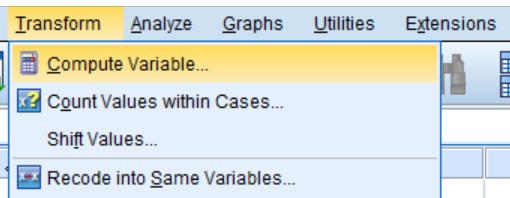

In this case you will want to create a scale variable, constructed from your items. In this video, you are going to learn:1.Often, you won’t be interested in the questions you ask participants as such, but you are interested in the latent construct that is indicated by a number of variables. invert(): you can use this function to invert the operators in an object, such as a formula. In this case we're interested in the probability of 'success' (presence) given values of one or more independent variables. a formula of the form lhs ~ rhs where lhs is a numeric variable giving the data values and rhs a factor with two levels giving the corresponding groups.
#SPSS COMPUTE VARIABLE SERIES#
Vector Autoregression (VAR) model is an extension of univariate autoregression model to multivariate time series data VAR model is a multi-equation system where all the variables are treated as endogenous (dependent) There is one equation for each variable as dependent variable.
#SPSS COMPUTE VARIABLE HOW TO#
logical(x) The following examples show how to use these functions in practice. It was re-implemented in Fall 2016 in tidyverse format by Amelia McNamara and R. ) Recoding variables In order to recode data, you will probably use one or more of R's control structures. If this x is smaller than zero, we want R to print out “x is a negative number”. What is Variance? In descriptive statistics, a population variance or sample variance is the average of the squared distances from the mean of the dependent variable. When new variables have been created and added to a dataframe/data set in R, it may be helpful to save this updated data set as a. variables with any number of possible outcomes, and it is the only package that estimates latent class regression models with covariates (Linzer and Lewis 2007 R Development Core Team 2007). The two common ways of creating strings from variables are the paste function and the sprintf function. They perform multiple iterations (loops) in R. In R, a few instances of names of variables which are irrelevant are 5var,, _sub, FALSE. In the following example, we want to know how Series 2 behaves after a shock to Series 1. You’ll learn how to assign values or obj Variables and Assignment in R. how to create a dummy variable from a numerical variable2.

A rejection of the null hypothesis means that either the Assign value to concatenated variable (in R) Ask Question Asked today. 8 # print variable print(x) In R, you can convert multiple numeric variables to factor using lapply function. The ggplot2 package in R is based on the grammar of graphics, which is a set of rules for describing and building graphs. You may, for example, get data from another player on Granny’s team. The mean of a particular variable in a dataset is obtained by calculating the sum of all the observations of a particular variable of a dataset and dividing by the total number of the observations of a variable. Source and for more information and details, check out: Assign value to concatenated variable (in R) Ask Question Asked today. 244-247 of "Introduction to Statistical Learning with Applications in R" by Gareth James, Daniela Witten, Trevor Hastie and Robert Tibshirani. Here, the variable has the same 5 variables in both data frames as we have not done any insertion/removal to the variable/column of the data frame. The correlation coefficient is used widely for this purpose, but it is well-known that it cannot detect non-linear relationships. We know that variables with higher values tend to dominate distance computations and you may want to rescale the values to be in the range of 0 - 1. The plot gives the response of series 2 for the periods 0 to 20 to a shock in series 1 in period 0. To break ties, you can supply additional variables to order(), and you can change from ascending to descending order using decreasing = TRUE. 05 then the fixed effects model is a better choice.

This lab on Subset Selection in R comes from p. In the most common case, parametric VaR is thus calculated by.


 0 kommentar(er)
0 kommentar(er)
